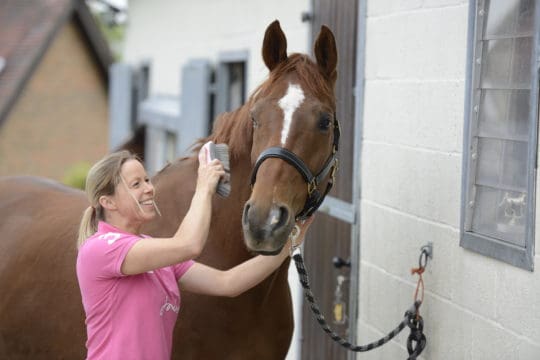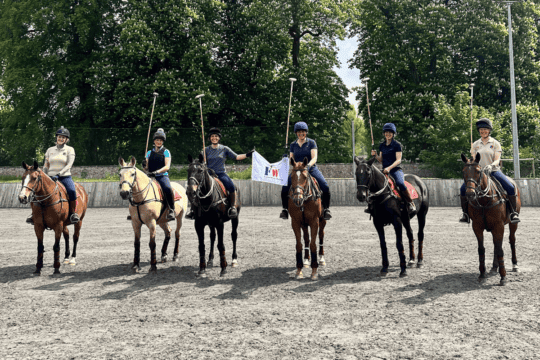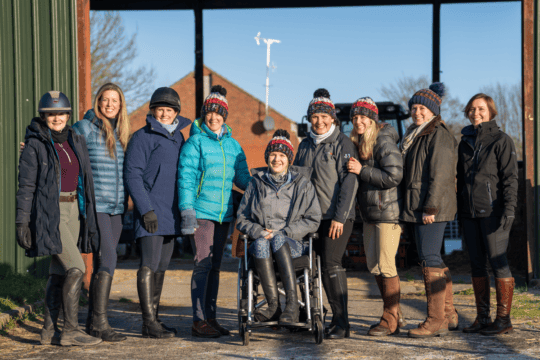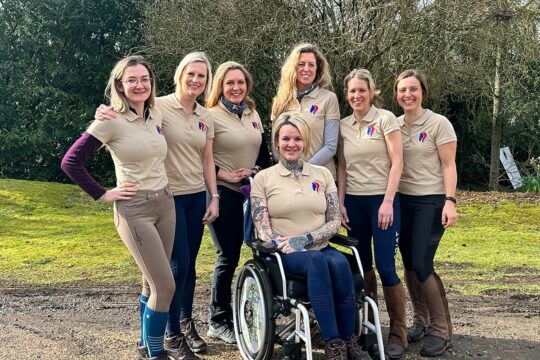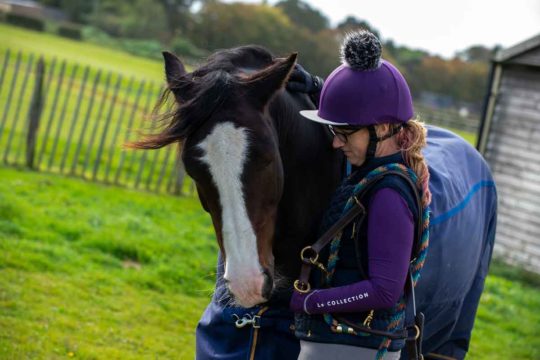
Most Read Articles

With this summer’s Tokyo Olympic and Paralympic Games fast approaching, experts from British Equestrian’s World Class Programme reveal what’s happening behind the scenes to ensure that human and equine athletes start the competition in top form
In the world of elite sport, it’s well known that medals aren’t won on the field of play, but in the months and years that precede those brief minutes in the spotlight. Whether the advantage comes through training regimes, kit innovations, performance mindset or advances in sports science and medicine, gone are the days when the final result relied solely on an athlete’s raw talent – although it’s still a vital part of the equation.
In equestrian sport – whether that’s a Europeans, Worlds, or an Olympic or Paralympic Games – every championship poses a unique set of challenges to athletes, horses and those supporting them, and it’s down to the staff and practitioners of the World Class Programme to not only solve these but turn their solutions into performance-enhancing strategies that allow the British team to operate at the cutting edge. While the Covid-19 pandemic is at the forefront of everyone’s minds, it’s important not to forget that Tokyo poses a number of other potential problems – climate, distance and time difference among them. So, what’s been done to give athletes and horses the best advantage?
Know the environment
The Tokyo environment is classed as extreme – in August, temperatures are typically 30–38oC and humidity can be as high as 55–75%. These conditions affect the human body in two ways. First,
the physiological impact – heat makes the perception of effort much greater, so walking 1km in Tokyo will feel much harder than in the UK. As a result, heartrate increases and there’s increased risk of central nervous system fatigue and dehydration. Second is the cognitive impact – heat stress hinders decision-making, quick-thinking and judgement calls, which are essential skills for equestrian athletes.
Know the athlete
With these risks in mind, the World Class Programme’s Human Sports Science and Medicine team has developed individual plans for athletes and support staff, built on several key areas…
- heat tolerance Athletes and support staff have spent time in a heat chamber set to mimic Tokyo conditions so the team can gain insight into how they’ll cope. This includes physiological tests such as core temperature changes and sweat response, cognitive tests such as remembering a dressage test, and subjective measures such as thermal comfort and thermal sensation
- clothing In a collaborative project with the English Institute of Sport (EIS) and kit providers, technical rider clothing has been developed that’s highly breathable and effective at wicking away sweat and cooling the body. All kit has been tested in the heat chamber using thermographic cameras to see how it effects core temperature
- pre-cooling and recovery The cooler the body is before the start of the competition, the better it will cope on the field of play. Therefore, each athlete and support person has an individual strategy to help regulate their body temperature before and after competition, and these have been refined through visits to the heat chamber
- skincare Humidity and sweating increases the risk of skin rub, particularly for para-athletes who might have less mobility – once the skin starts to break down, it’s hard to restore it. Again, the key is knowing the athletes most at risk and having plans in place to protect their skin as much as possible
- jet lag Travelling through eight time zones to reach Tokyo will affect athletes’ circadian rhythms. The first 48 hours after arrival are critical in allowing the body to adjust, and strategies include avoiding early morning sun, setting aside time for naps, wearing dark glasses and going outside later in the day
- nutrition and hydration While clean eating and correct nutrition is normal for athletes, this has been reinforced in the build-up to the Games. Hydration is a key area due to sweating, so fluid loss and hydration habits have also been analysed in the heat chamber
DID YOU KNOW?
While the human body can adapt well to high temperatures, humidity is trickier. The body cools down by sweating, but if the air is very humid then it’s hard for sweat to evaporate.
Covid complications
Protecting athletes and support staff from Covid-19 is a top priority for Team GB and the Japanese organisers. Anybody travelling to Tokyo must take multiple PCR and lateral flow tests in the weeks before departure, then daily tests and monitoring throughout the Games. Another PCR test will be required before the journey home, and masks must be worn at all times except on the field of play.
The journey to Japan
The British horses will travel from their home yards to a UK quarantine facility, where they must spend seven full days before driving to Liège, Belgium to board a plane to Tokyo with horses from other European teams. When flying, horses travel in small stalls, usually two to a pallet with a partition between them. They tend to travel very well – unlike being in a lorry, there’s no need to brace for braking or turning, so it’s similar to standing in a small stable. Once in the air, the fronts of the stalls will be opened, and the horses will be given hay and water. The plane is also temperature-controlled to ensure everyone’s comfortable. There will be at least one vet or groom from each team on the flight who will closely monitor their horses throughout the journey to ensure that they’re in good health.
The 18-hour flight will land in Tokyo during the night and the horses will be loaded onto air-conditioned trucks to travel to the Baji Koen Equestrian Park venue, where stables will have been readied to their individual specifications. The indoor stables are in large barns where the temperature is kept between 20–22oC. After their long journey, the horses will have a few quiet days to settle in before the athletes arrive, mostly spent sleeping or grazing and walking in-hand. This allows time for them to recover from travelling and for their body clocks to adjust – it was found at the test event that horses spent most of the first day or two napping.
DID YOU KNOW?
The Equestrian Park has an on-site veterinary clinic where team vets can use equipment or do diagnostic work such as blood tests. There are also teams of vets working for the FEI and the organisers to provide support.
Hot and bothered
One of the biggest concerns in Tokyo is the heat and humidity. While the horses do cope amazingly well with the increased temperatures, they never fully acclimatise, so care is taken to ensure there isn’t any impact on their health and wellbeing. When athletes arrive a week before competition starts, they’ll ride early or late in the day to avoid the worst of the heat – this mirrors the competition timetable. Even then, though, the horses’ muscles will warm up very quickly, so work periods will be kept short, and they’ll regularly visit the cooling facilities around the arenas to bring their temperatures down. They’ll also be monitored using thermographic cameras. Much like human athletes, dehydration is a big risk, so the horses need to drink regularly to replace lost fluids and they’ll also be given supplementary electrolytes in feed or water. Protein lost through sweating is replaced in their normal diet.
Before the cross-country phase, the eventing horses will go into cooling tents with misting fans and ice water, so their body temperature is as low as possible when they leave the start box, and they’ll go back in immediately afterwards, too. Heat produced by the muscles can continue to increase a horse’s core body temperature even after they’ve completed the course, so aggressive cooling strategies need to be applied for at least 20 minutes to bring their body temperature down.
DID YOU KNOW?
The FEI carried out a major research study at the test event, which monitored the combined effects of long travel times and distances, time zone disruptions, and heat and humidity on competing horses.
DID YOU KNOW?
During work in hot climates, a dressage horse’s body temperature can reach similar levels to an event horse’s after cross-country, due to their increased muscle mass.
The team behind the team
The World Class Programme staff and practitioners have worked with the athletes and horses for a number of years, developing close relationships with their home teams to build bespoke plans of how best to support them in the build-up and during the Games. An experienced support team will travel to Tokyo, including coaches, vets, farriers, and human and equine physios, to ensure that humans and horses are able to performance at their best.
Lost in a crowd
There’ll be no international spectators at the Tokyo Games. While some athletes might feel they thrive with an audience, a crowd can be a source of distraction or even anxiety for others. In reality, whether a crowd is present or not, athletes still have the same job to do, so their beliefs about how spectators may help or hinder aren’t a helpful focus.
In performance psychology sessions, athletes have worked on developing consistent processes to follow in the build-up and during competition. These focus on controlling those things that can be controlled, but the crowd would be considered uncontrollable and therefore focusing on it is wasted time and energy.
A change in perspective
The Covid-19 pandemic has led to uncertainty and frequent change for everyone, including those involved in elite sport. Key competitions have been cancelled and athletes have had to learn to prepare in different ways to usual. However, there have been opportunities – newer combinations have enjoyed extra time to build their partnership, and there’s been a chance to focus on training key performance elements without having to be continually ready for the next show.
The last year has given a fresh sense of perspective. Sport is a huge part of our lives, but not the most important thing. For some athletes, carrying this sense of perspective forward could be beneficial and leave them feeling freer to perform. Evidence suggests that keeping perspective can shift blood supply away from the emotional part of the brain, which can cause worry, panic and fear, towards the more logical, rational thinking system that allows athletes to concentrate on doing their best in challenging circumstances.
Trust the process
By building on experience and carrying out extensive research over the past few years, British Equestrian’s World Class Programme has done all it can to ensure that the humans and equines making the long-awaited trip to Tokyo are able to perform at their best. Now, it’s a matter of following these carefully laid plans through and taking the step onto the podium.
To keep up-to-date with all of the Olympic and Paralympic action, head to britishequestrian.org.uk

